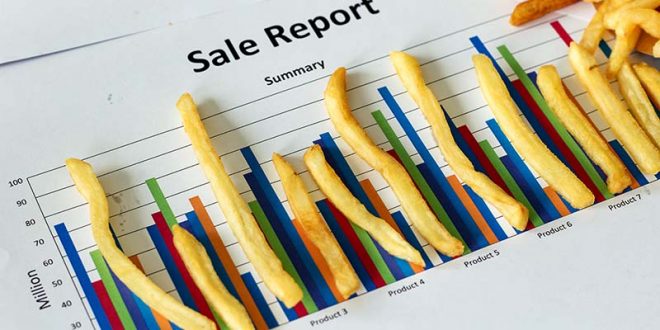During the 2022 US fiscal year (starting on October 1, 2021, and ending on September 30, 2022), Lamb Weston Holdings, Inc. gross profit margins will probably remain below pre-pandemic levels, according to the latest statement of Tom Werner, President, and CEO of LW.
Based on his current statement, the LW reports on the fiscal year first quarter 2022 results (FY 2022), and updates on the FY 2022 outlook, only the net sales show an increase of 13% to USD984m. The rest (income from operations, net income, diluted EPS, and adjusted EBITDA) shows two-digits margin declines to remain below pre-pandemic levels through FY 2022.
“Our first-quarter sales results reflect the ongoing broad recovery within the frozen potato category, with overall demand in North America near pre-pandemic levels, and our shipments improving in each of our core restaurant and foodservice sales channels,” said Tom Werner, President, and CEO of LW. “However, the impact of extreme summer heat that negatively affected potato crops in the Pacific Northwest, combined with industry-wide operational challenges, including highly inflationary input and transportation costs, labor availability, and upstream and downstream supply chain disruptions, will result in higher costs as the year progresses, and significantly pressure our earnings. Accordingly, we expect our gross profit margins to remain below pre-pandemic levels through fiscal 2022.”
Increased Sales Volumes, More than Offset by Higher Costs. Frozen Potatoes Saves LW’s Day
Net sales increased to USD984.2m, up 13% versus FY 2021 first quarter, with volume up 11% and price/mix up 2%. The increase in sales volumes predominantly reflected the recovery in demand for frozen potato products outside the home, which more than offset the decline in retail volume that largely resulted from lower shipments of private label products resulting from incremental losses of the certain low-margin business, and as food-at-home purchases begin to normalize to pre-pandemic levels. Pricing actions, including the benefit of higher prices charged to customers for product delivery, as well as a favorable mix, drove the increase in price/mix in each of the LW’s core business segments.
Income from operations declined USD75.5m to USD60.2m, down 56% versus the FY 2021 first quarter, reflecting lower gross profit and higher selling, general and administrative expenses (“SG&A”). Gross profit declined USD62.5m, as the benefit of increased sales volumes was more than offset by higher manufacturing and distribution costs on a per-pound basis. The higher costs per pound predominantly reflected double-digit cost inflation from key inputs, particularly edible oils, and transportation, particularly trucking and ocean freight. In addition, LW incurred higher manufacturing costs per pound due to volatile labor availability, which was in part a result of COVID-related absenteeism, that affected production run-rates and throughput. The decline in gross profit also included a USD5.6m decrease in unrealized mark-to-market adjustments associated with commodity hedging contracts, which includes a USD1.2m gain in the current quarter, compared with a USD6.8m gain related to these items in the prior-year quarter.
SG&A increased USD13.0m compared to the prior-year quarter, primarily due to investments to improve the LW’s information technology, commercial, and supply chain operations over the long term, as well as increased compensation and benefits expenses. These investments included more than USD4m of non-recurring expenses (primarily consulting expenses) associated with a new enterprise resource planning system (“ERP”), compared to approximately USD1m in the prior-year quarter. In addition, advertising and promotional expenses (“A&P”) increased USD2.9m, largely in support of the launch of new products in the Retail segment.
Net income was USD29.8m, down USD59.5m versus the prior-year quarter, and Diluted EPS was USD0.20, down USD0.41 versus the prior-year quarter, driven by a decrease in income from operations and equity method investment earnings.
Adjusted EBITDA including unconsolidated joint ventures declined USD78.4m to USD123.4m, down 39% versus the prior-year quarter, driven by lower income from operations and equity method investment earnings.
Fiscal 2022 Outlook
LW continues to expect FY 2022 net sales growth will be above its long-term target of low-to-mid single digits. The company continues to anticipate net sales growth in the second quarter of FY 2022 will be driven largely by higher volume, reflecting an ongoing recovery in demand for frozen potato products, as well as a favorable comparison to relatively soft shipments in the second quarter of FY 2021.
“The company continues to expect net sales growth in the second half of fiscal 2022 to reflect more of a balance of higher volume and improved price/mix as recent pricing actions are fully implemented in the market,” according to the latest LW’s press release.
The company expects net income and Adjusted EBITDA including unconsolidated joint ventures will be pressured for the remainder of FY 2022, as it manages through significant inflation for key production inputs, packaging, and transportation compared to FY2021 levels, as well as industry-wide operational challenges, including labor availability, and upstream and downstream supply chain disruptions, resulting from volatility in the broader supply chain as the overall economy continues to recover from the pandemic’s impact.
In addition, LW’s officials expect the company’s potato costs on a per pound basis will likely rise as the year progresses due to the extreme summer heat that negatively affected the quality of potato crops in the Pacific Northwest. Accordingly, LW expects gross margins to remain below pre-pandemic levels through fiscal 2022. The company previously expected earnings to gradually approach pre-pandemic levels in the second half of FY 2022.
